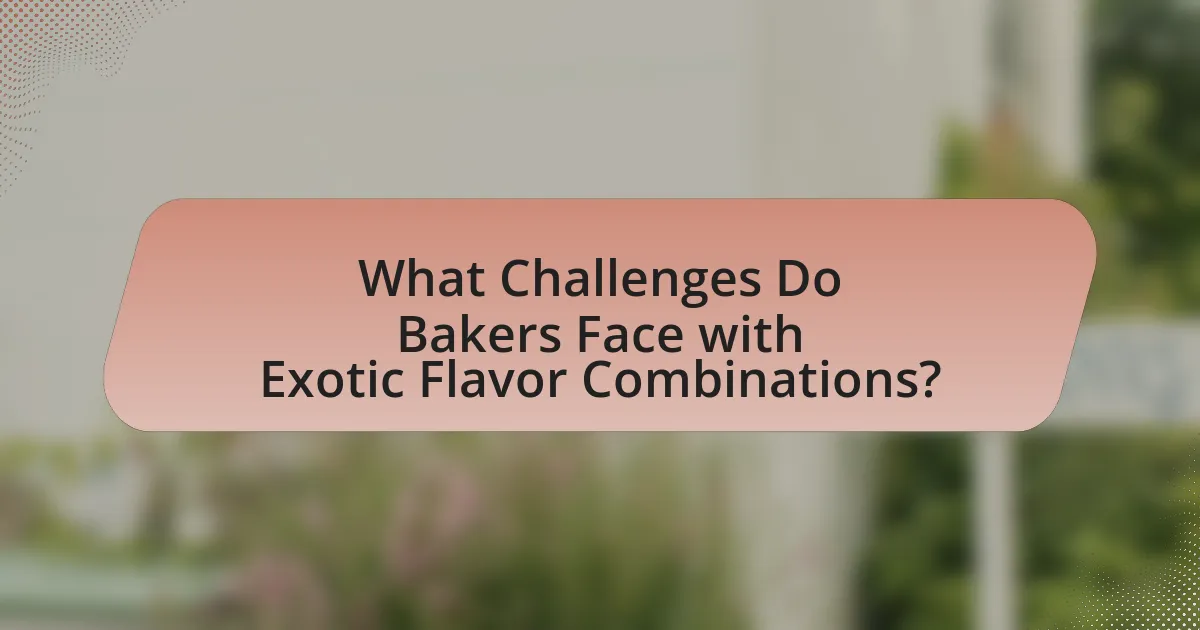The article focuses on new trends in exotic flavor combinations for wedding cakes, highlighting unique pairings such as lavender and lemon, matcha and white chocolate, and coconut with passion fruit. It explores how these flavors are integrated into cake designs, the influence of cultural elements, and the emotional connections they evoke for couples. Additionally, the article discusses the challenges bakers face in sourcing exotic ingredients and maintaining flavor consistency, while providing strategies for overcoming these obstacles. Couples are encouraged to consider their personal tastes and cultural backgrounds when selecting flavors, reflecting a growing preference for bold and non-traditional options in wedding cakes.

What are the New Trends in Exotic Flavor Combinations for Wedding Cakes?
New trends in exotic flavor combinations for wedding cakes include unique pairings such as lavender and lemon, matcha and white chocolate, and coconut with passion fruit. These combinations reflect a growing preference for bold and unexpected flavors that enhance the traditional cake experience. For instance, lavender and lemon provide a floral and citrusy balance, while matcha and white chocolate offer a rich, earthy taste complemented by sweetness. Additionally, the use of tropical ingredients like coconut and passion fruit caters to couples seeking a refreshing and vibrant flavor profile. These trends are supported by the increasing popularity of artisanal baking and the desire for personalized wedding experiences, as evidenced by surveys indicating that 60% of couples are opting for non-traditional flavors in their wedding cakes.
How are exotic flavors being integrated into wedding cake designs?
Exotic flavors are being integrated into wedding cake designs through innovative flavor pairings and unique ingredient selections that reflect diverse culinary traditions. Bakers are increasingly incorporating ingredients such as matcha, yuzu, lavender, and cardamom to create distinctive taste profiles that appeal to modern couples seeking personalized experiences. This trend is supported by consumer demand for unique and memorable wedding experiences, as evidenced by a 2022 survey from The Knot, which indicated that 30% of couples are opting for non-traditional flavors in their wedding cakes.
What are some popular exotic flavors currently trending?
Some popular exotic flavors currently trending include yuzu, matcha, and lavender. Yuzu, a citrus fruit from East Asia, offers a unique tartness that enhances desserts. Matcha, a finely ground green tea powder, provides a rich, earthy flavor that is increasingly favored in wedding cakes. Lavender, known for its floral notes, adds a sophisticated touch and pairs well with various other flavors. These flavors are gaining popularity due to their ability to create distinctive and memorable taste experiences in wedding cakes.
How do cultural influences shape these flavor combinations?
Cultural influences shape flavor combinations in wedding cakes by integrating traditional ingredients and techniques from various cuisines. For instance, the use of spices like cardamom and saffron in Indian desserts reflects regional preferences, while the incorporation of tropical fruits like mango and coconut in Caribbean cakes showcases local agricultural products. These combinations often arise from historical trade routes and migration patterns, which introduce new flavors and culinary practices to different cultures. The blending of these elements results in unique flavor profiles that resonate with diverse cultural identities, enhancing the overall experience of wedding celebrations.
Why are couples opting for exotic flavors in their wedding cakes?
Couples are opting for exotic flavors in their wedding cakes to create unique and memorable experiences that reflect their personal tastes and cultural backgrounds. This trend is driven by a desire for individuality and the increasing popularity of global cuisine, as couples seek to differentiate their celebrations from traditional offerings. For instance, flavors such as matcha, lavender, and tropical fruits have gained traction, appealing to adventurous palates and enhancing the overall aesthetic of the wedding. The rise in social media sharing also encourages couples to choose visually striking and unconventional flavors that can captivate guests and create shareable moments.
What emotional connections do these flavors evoke for couples?
Exotic flavors in wedding cakes evoke emotional connections for couples by symbolizing adventure and shared experiences. These unique combinations, such as passion fruit and coconut or lavender and honey, often remind couples of special moments, like vacations or significant milestones, enhancing their bond. Research indicates that sensory experiences, including taste, can trigger memories and emotions, reinforcing the idea that flavors can deepen relational intimacy. For instance, a study published in the Journal of Consumer Research highlights how specific tastes can evoke nostalgia, making these flavors particularly meaningful for couples celebrating their union.
How do exotic flavors enhance the overall wedding experience?
Exotic flavors enhance the overall wedding experience by providing unique and memorable taste sensations that elevate the celebration. These flavors, such as passion fruit, matcha, or cardamom, create a distinctive culinary experience that can surprise and delight guests, making the event more enjoyable. Research indicates that incorporating diverse flavors can stimulate the senses and foster emotional connections, which is crucial during significant life events like weddings. For instance, a study published in the Journal of Sensory Studies found that novel flavor combinations can enhance overall satisfaction and create lasting memories associated with the event.

What are the Most Popular Exotic Flavor Combinations for Wedding Cakes?
The most popular exotic flavor combinations for wedding cakes include lavender and lemon, coconut and lime, and chai spice with vanilla. Lavender and lemon provide a floral and citrusy balance, appealing to couples seeking a refreshing taste. Coconut and lime offer a tropical twist, often favored for beach-themed weddings. Chai spice combined with vanilla delivers a warm, aromatic flavor profile, reflecting a growing trend towards incorporating spices in desserts. These combinations are increasingly chosen for their unique tastes and ability to create memorable experiences for wedding guests.
Which unique flavor pairings are gaining popularity?
Unique flavor pairings gaining popularity in wedding cakes include lavender and lemon, matcha and white chocolate, and cardamom with orange. These combinations are increasingly favored for their ability to provide a sophisticated and refreshing taste experience. For instance, lavender and lemon create a floral yet zesty profile that appeals to modern palates, while matcha and white chocolate offer a unique balance of earthy and sweet flavors. Cardamom with orange adds a warm spice element that enhances the overall flavor complexity, making these pairings stand out in contemporary wedding cake trends.
How do tropical fruits pair with traditional cake flavors?
Tropical fruits pair well with traditional cake flavors by adding vibrant, refreshing notes that enhance the overall taste experience. For instance, pineapple complements vanilla cake with its sweetness and acidity, while mango adds a rich, creamy texture to buttercream frosting. Additionally, coconut’s nutty flavor harmonizes with chocolate cake, creating a tropical twist on a classic dessert. These combinations are supported by culinary trends that emphasize bold, exotic flavors in wedding cakes, appealing to modern palates seeking unique experiences.
What role do spices play in creating exotic flavor profiles?
Spices are essential in creating exotic flavor profiles by introducing unique and complex taste elements that enhance the overall sensory experience. They contribute distinct aromas and flavors, such as the warmth of cinnamon, the heat of chili, or the earthiness of cardamom, which can transform ordinary ingredients into extraordinary combinations. For instance, the use of saffron in desserts not only adds a luxurious flavor but also a vibrant color, making the dish visually appealing. Historical culinary practices show that spices have been used for centuries to elevate dishes, with cultures around the world incorporating them to create signature flavors that define their cuisines. This rich tradition underscores the importance of spices in developing innovative and exotic flavor combinations, particularly in contemporary wedding cake designs that seek to surprise and delight.
How do bakers create these exotic flavor combinations?
Bakers create exotic flavor combinations by experimenting with unique ingredients and techniques that enhance traditional recipes. They often incorporate unexpected elements such as spices, herbs, and fruits from various cuisines, allowing for innovative pairings like lavender and lemon or cardamom and pistachio. This approach is supported by culinary trends that emphasize fusion and global influences, as seen in the rise of flavors like matcha and yuzu in Western desserts. Additionally, bakers may utilize flavor pairing principles, which suggest that certain ingredients complement each other based on their chemical compounds, further guiding their creative process.
What techniques are used to blend flavors effectively?
Techniques used to blend flavors effectively include balancing, layering, and contrasting flavors. Balancing involves ensuring that no single flavor overpowers others, often achieved by adjusting sweetness, acidity, and saltiness. Layering flavors means incorporating different elements at various stages of preparation, allowing them to build complexity; for example, using a citrus zest in the batter and a citrus glaze on top. Contrasting flavors, such as pairing sweet with salty or spicy, enhances the overall taste experience, making it more dynamic. These techniques are supported by culinary principles that emphasize harmony and complexity in flavor profiles, essential for creating appealing wedding cakes.
How do bakers ensure flavor balance in wedding cakes?
Bakers ensure flavor balance in wedding cakes by carefully selecting and combining complementary flavors, textures, and sweetness levels. They often conduct taste tests to evaluate how different ingredients interact, ensuring that no single flavor overpowers the others. For instance, a common approach is to pair rich flavors like chocolate with lighter elements such as fruit or cream to create a harmonious blend. Additionally, bakers may use flavor enhancers like citrus zest or spices to elevate the overall taste profile without overwhelming the cake. This method is supported by culinary principles that emphasize the importance of balance in flavor profiles, which is crucial for creating a pleasing dessert experience.

What Challenges Do Bakers Face with Exotic Flavor Combinations?
Bakers face several challenges when incorporating exotic flavor combinations into their creations. One significant challenge is balancing the intensity of flavors, as some exotic ingredients can overpower traditional cake flavors, leading to an unappealing taste profile. Additionally, sourcing high-quality exotic ingredients can be difficult, as they may not be readily available or may vary in quality, impacting the final product. Furthermore, bakers must also consider customer preferences and cultural sensitivities, as not all clients may be open to trying unconventional flavors. These challenges highlight the need for careful experimentation and market research to ensure successful integration of exotic flavors into wedding cakes.
What are the common obstacles in sourcing exotic ingredients?
Common obstacles in sourcing exotic ingredients include limited availability, high costs, and regulatory challenges. Limited availability arises because many exotic ingredients are not widely cultivated or are sourced from specific regions, making them difficult to obtain consistently. High costs are often associated with the transportation and importation of these ingredients, which can significantly increase the final price for consumers. Regulatory challenges can involve strict import regulations and quality control standards that vary by country, complicating the procurement process. These factors collectively hinder the ability of businesses to incorporate exotic flavors into their offerings, such as wedding cakes.
How do seasonal availability and cost affect ingredient choices?
Seasonal availability and cost significantly influence ingredient choices in wedding cake preparation. Ingredients that are in season tend to be fresher, more flavorful, and less expensive, making them preferable for bakers. For example, strawberries are typically abundant and cheaper in late spring and early summer, allowing for their use in cakes during that period. Conversely, out-of-season ingredients often incur higher costs due to transportation and storage, which can lead bakers to opt for alternatives that are more cost-effective and readily available. This economic consideration drives the selection of flavors and combinations, as bakers aim to balance quality with budget constraints while also appealing to seasonal trends in flavor preferences.
What are the challenges in maintaining flavor consistency?
Maintaining flavor consistency in wedding cakes presents several challenges, primarily due to ingredient variability, production methods, and environmental factors. Ingredient variability arises from differences in quality and flavor profiles of raw materials, such as fruits, spices, and extracts, which can change based on season and sourcing. Production methods, including mixing techniques and baking times, can also affect flavor outcomes, as slight variations can lead to significant differences in taste. Environmental factors, such as humidity and temperature during storage and transportation, can further alter flavor perception. These challenges necessitate rigorous quality control measures and standardized recipes to ensure a consistent flavor experience across batches.
How can bakers overcome these challenges?
Bakers can overcome challenges related to new trends in exotic flavor combinations for wedding cakes by conducting thorough market research and experimenting with diverse ingredients. By understanding customer preferences and current trends, bakers can tailor their offerings to meet demand. Additionally, testing flavor pairings in small batches allows bakers to refine recipes before introducing them to a wider audience. For instance, a survey by the American Bakers Association indicated that 60% of consumers are interested in unique flavor profiles, highlighting the potential for success in this area.
What strategies can be employed for ingredient sourcing?
Effective strategies for ingredient sourcing include establishing direct relationships with local farmers and suppliers, utilizing online marketplaces for specialty ingredients, and implementing a robust inventory management system. Direct relationships with local farmers ensure access to fresh, high-quality ingredients while supporting the local economy. Online marketplaces provide a wide range of exotic ingredients that may not be available locally, allowing for unique flavor combinations. A robust inventory management system helps track ingredient availability and reduces waste, ensuring that the necessary components for innovative wedding cake flavors are always on hand. These strategies collectively enhance the quality and uniqueness of wedding cakes, aligning with current trends in exotic flavor combinations.
How can bakers experiment with flavor combinations effectively?
Bakers can experiment with flavor combinations effectively by utilizing a systematic approach that includes pairing complementary flavors, conducting small batch tests, and seeking feedback. Complementary flavors enhance each other; for example, chocolate pairs well with coffee or sea salt. Conducting small batch tests allows bakers to refine their recipes without significant waste, enabling them to adjust ratios and ingredients based on taste. Seeking feedback from taste testers provides valuable insights into the appeal of the combinations, guiding bakers toward successful flavor profiles. This methodical approach is supported by culinary studies that emphasize the importance of flavor pairing and consumer preferences in baking.
What Tips Can Couples Consider When Choosing Exotic Flavors for Their Wedding Cakes?
Couples should consider their personal tastes and cultural backgrounds when choosing exotic flavors for their wedding cakes. This approach ensures that the flavors resonate with their identities and preferences. For instance, incorporating flavors like matcha, lychee, or passion fruit can reflect unique culinary experiences. Additionally, couples should sample various combinations to find harmonious pairings, such as coconut and lime or chocolate and chili, which can enhance the overall taste profile. Research indicates that flavor trends in weddings are increasingly leaning towards bold and adventurous choices, with a 2022 survey showing that 45% of couples opted for non-traditional flavors. This data supports the idea that exploring exotic flavors can create a memorable and personalized cake experience.
